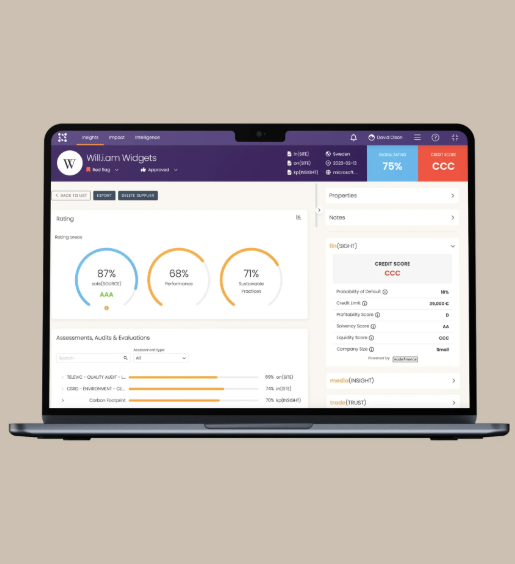Maximizing Supplier Risk Management with Supply Chain Risk Management Tools

In today’s interconnected world, managing supplier risks is a crucial part of ensuring business continuity and success. Supply chain risk management tools are designed to help businesses identify vulnerabilities, assess risks, and implement effective mitigation strategies. These tools are essential for monitoring suppliers and aligning with best practices to address modern challenges in supply chain management.
This blog post explores the importance of supply chain risk management tools, their key features, and how they contribute to building a robust supplier risk management framework.
What Are Supply Chain Risk Management Tools?
Supply chain risk management tools are digital solutions that help businesses evaluate and manage the risks associated with their supply chains. These tools provide critical insights, enabling companies to maintain resilience and minimize disruptions across their supply networks.
Key Features of Supply Chain Risk Management Tools
- Risk Identification: These tools help detect potential risks related to suppliers, logistics, and external factors that could impact the supply chain.
- Real-Time Monitoring: Track supplier performance and key risk indicators continuously to stay ahead of potential disruptions.
- Risk Prioritization: Classify and rank risks based on their severity and impact, allowing businesses to focus on the most critical threats.
- Predictive Analytics: Leverage data analytics to anticipate future risks and create proactive plans.
- Compliance Tracking: Ensure suppliers adhere to legal, regulatory, and ethical standards.
Benefits of Using Supply Chain Risk Management Tools
- Enhanced Supplier Risk Monitoring: These tools offer visibility into supplier operations, allowing businesses to continuously track performance and detect issues before they become problems.
- Streamlined Decision-Making: Centralized platforms for risk data simplify decision-making, making it easier for managers to take timely, informed actions.
- Improved Resilience: By utilizing predictive analytics and robust risk assessments, organizations can better withstand unexpected challenges, such as supply chain disruptions or financial setbacks.
- Cost Efficiency: Early detection and prevention of potential disruptions save businesses time and resources, reducing the financial impact of unanticipated events.
Exploring Supply Chain Risk Software
Supply chain risk software is a more advanced solution that integrates technologies like artificial intelligence (AI) and machine learning (ML). These features allow for more accurate predictions and faster data processing, giving businesses better insights into their supplier networks.
Key Features of Supply Chain Risk Software:
- Data Integration: Aggregates data from multiple sources for a comprehensive analysis of risks.
- Customizable Dashboards: Provides tailored views of risk metrics and trends for different stakeholders.
- Scenario Analysis: Simulates potential disruptions to assess how the supply chain would respond and evaluate strategies.
- Collaborative Features: Facilitates communication and coordination among internal teams and external stakeholders.
The Role of Supply Chain Risk Assessment Software
Supply chain risk assessment software is designed to evaluate vulnerabilities within the supply chain. It helps organizations systematically assess risks to ensure all potential threats are considered and addressed.
Steps in Using Risk Assessment Software:
- Data Collection: Gather relevant data about suppliers, market conditions, and operational processes.
- Risk Categorization: Classify risks into categories, such as financial, operational, and compliance risks.
- Scoring and Prioritization: Assign risk scores based on the likelihood and impact of each identified risk.
- Action Planning: Develop and implement strategies to mitigate high-priority risks.
This structured approach ensures comprehensive risk evaluation and effective mitigation actions.
Types of Supply Chain Risk Tools for Comprehensive Management
Supply chain risk tools come in modular formats to address specific areas of risk management, such as:
- Supplier Risk Management Solutions: Track supplier performance, financial stability, and compliance with regulations.
- Logistics Risk Monitoring: Identify and mitigate risks related to transportation and distribution.
- Market Risk Analysis: Monitor external factors like geopolitical issues and economic trends that can affect the supply chain.
By combining these tools, organizations can create a well-rounded risk management strategy that covers all critical aspects of their supply chain.
Types of Risks in Supply Chains
Supply chains are exposed to various risks that can disrupt operations:
- Operational Risks: Disruptions from inefficiencies or failures in supplier processes.
- Financial Risks: Risks such as supplier insolvency or inability to fulfill contracts.
- Compliance Risks: Failure to meet legal, regulatory, or industry standards.
- Environmental Risks: Natural disasters or environmental factors that affect operations.
- Geopolitical Risks: Trade restrictions, tariffs, or political instability that impact global suppliers.
Best Practices for Managing Supply Chain Risks
- Diversify Suppliers: Reducing reliance on a single supplier can help mitigate the risks of supply chain disruptions.
- Enhance Transparency: Utilize digital tools to track supplier performance and risks in real-time.
- Conduct Regular Audits: Ensure ongoing compliance and assess operational efficiency by auditing suppliers periodically.
- Invest in Technology: Leverage advanced tools for continuous monitoring, predictive analytics, and real-time risk tracking.
Choosing the Right Supply Chain Risk Management Software
When selecting supply chain risk management software, it’s important to consider the following factors:
- Scalability: Choose software that can accommodate both current and future needs as your vendor network expands.
- Integration Capabilities: Opt for platforms that seamlessly integrate with your existing systems, such as procurement or ERP tools.
- User-Friendliness: A platform with an intuitive interface reduces the learning curve and increases adoption among team members.
- Customer Support: Ensure the provider offers robust customer support, including training and troubleshooting assistance.
Solutions for a Resilient Supply Chain
Supply chain risk solutions are designed to help businesses adopt a proactive approach to risk management, ensuring long-term resilience. These solutions include various tools, technologies, and strategies that mitigate both current and emerging risks.
Examples of Risk Management Solutions:
- Blockchain Technology: Offers enhanced transparency and traceability within supply chain networks.
- AI-Powered Analytics: Provides real-time insights into potential risks, enabling companies to make data-driven decisions.
- Cloud-Based Platforms: Support remote monitoring and facilitate collaboration among teams and stakeholders.
Conclusion
Supply chain risk management tools and software are indispensable for businesses seeking to monitor and address supplier risks effectively. These solutions provide visibility, predict potential disruptions, and streamline decision-making processes. By investing in the right risk management tools, companies can enhance resilience, reduce operational interruptions, and maintain a competitive edge in today’s fast-paced marketplace.
With the right strategies and technologies, businesses can confidently navigate supply chain complexities and ensure long-term success.


 English
English 












































































































































































































































































































































































